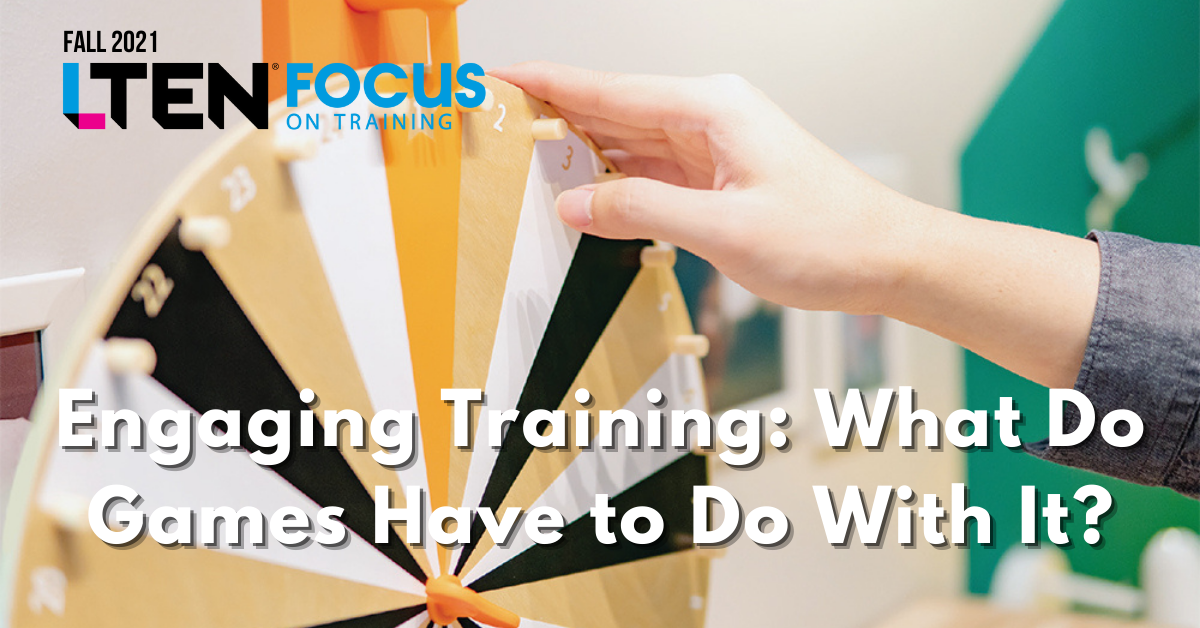
Engaging Training: What Do Games Have to Do With It?
Feature Story – By Vijayshree Rautela
Adult learners always learn best by being involved
In today’s fast-evolving digital world, people have limited time yet many tasks and goals to accomplish, and success and dreams to pursue. Their minds are hungry for information, scanning for what would help them get to the next level.
There’s a lot of training available depending on learners’ needs. It is full of the required content and information. However, some training can sometimes be boring and uninspiring to the learners.
But what if?
- What if there is a trick to lure learners to a training like viewers to a movie or sporting event?
- What if curiosity, intrigue, doing, winning and entertaining become part of a training?
- What if once a training is completed, learners can’t stop talking about the engaging elements used in it to make the content more relatable and comprehensible?
The answer to these what-ifs lies in an engaging elements cognitive training strategy. Learning new content can be made engaging if a training has a storyline, characters, animations and not to mention interactive games to make the content more relatable and comprehensible. Adult learners always learn best by doing and by being involved in what they need to learn.
 Why Cognitive?
Why Cognitive?
The term cognitive is used because when we use engaging elements in a training like popular games, gaming strategies, characters, storyline, popular music, etc., learners can recall experiences related to these elements from their memory. This makes it easy to understand new concepts. It is like using the known from a learners’ brain to understand the new and make it more relatable.
Passive learning is no longer a part of the evolving digital learning age. This strategy always results in higher learner enrollment, effective learning and greater learning retention.
Cognitive learning using engaging elements is more effective in adult learners as they have a large expanse of life experiences that they can recall and apply to make decisions, especially if a game requires a decision or action to be made.
Game-Based Learning
Games always evoke feelings of challenge, competition, intrigue, solving problems and winning, as well as learning from failures. If you can intrigue the learners, you can engage them. If you can engage the learners, you can make them easily learn new concepts. It’s highly effective too for learners with attention deficit.
Learning styles can be categorized as auditory, visual and kinesthetic. Gamebased learning usually incorporates all these three learning styles, making it a highly effective mechanism to learn new concepts.
Most games have interesting animations and graphics catering to the visual element. In terms of the audio learning style examples, games usually have audio or music in the background, it could even be a discussion or dialogue, or sound effects to celebrate wins or address losses.
Kinesthetic examples include scenarios where learners learn by doing, solve a puzzle or problem, search or interpret answers, for example, in a crossword.
Game-based learning can also have several levels of complexity as content is organized according to complexity levels from beginner, intermediate and advanced. As learners pass a beginner’s level, they are elevated to play a more complex level game, where the learning content is of the next level.
 Game Types & Platforms
Game Types & Platforms
In today’s digital world that’s constantly evolving, there are numerous training delivery platforms. These include the traditional classroom learning, self-paced Web-based learning, virtual live and recorded learning sessions using virtual communication tools, the most in-vogue mobile learning and hybrid learning. There are so many choices of training delivery that learners can choose the platform the suits them best.
Game-based learning in all these different training delivery platforms can also be a collaborative process with multiple learners being part of a game where each solves a problem to a learn a concept and learn from other learners’ solutions. For example, putting a puzzle together, where each component of a puzzle has a hint to where it would fit in the puzzle and multiple learners complete the puzzle, learning along the way from each other’s solutions and their own.
There are limitless creative ways to incorporate games in learning. An entire training could be a single game to learn new concepts. It could also have several games related to the content and integrated within a training to break the monotony of going through extensive content.
These games could either be testing the knowledge of concepts already learned in the training or could be teaching new concepts. For example, a game in an online training could be a treasure hunt, where the learner searches for steps of a process hidden in a picture and clicks on them to identify them. They could get points, badges or trophies for identifying the correct steps.
Treasure hunts, puzzles, crosswords, Wheel of Fortune, Jeopardy and navigating through a maze are the types of games most people are already familiar with and are also popular with the masses. Incorporating them in training via a suitable training delivery platform can be an effective engaging method to learn new concepts or quiz learners on the same.
Soft skills training also can be highly effective when taught via various game-based
exercises.
VR Experience & Mobile Learning
Gamification could also be a virtual reality (VR) experience for new hires. Learners could be transported online into a virtual world of their actual job, view how certain processes and tasks are performed and asked to simulate the same in the virtual environment before they join the organization. This could especially be effective for customer service-related jobs, call centers, marketing or sales.
Most game-based learning short tutorials can be highly effective in mobile learning. People on the go have more time to spend on their phones than being in front of a computer or being in a classroom. Learners can go through an engaging game-based tutorial that teaches them new concepts while they are waiting in a doctor’s room, are on a plane or just having some alone time with themselves.
Learning was never meant to be stressful, and mobile learning with short tutorial games can be highly effective. It’s like feeding the brain on the go.
The Future of Game-Based Learning
It’s pertinent to remember that game-based learning should include games that are known to the masses. Learners already need a learning curve to understand the content taught in a training. Trying to understand the rules of a complex game could be a put-off for the learners.
In today’s advancing technology age, a lot of e-learning authoring tools like Adobe Captivate, Articulate and others already come with game templates that can be used to integrate the learning content and deliver it via a game. These game templates can be easily customized to reflect specific colors, fonts, appearance and level of content. This contrasts with some years back when such templates were not available, and games had to be created in Flash and similar tools.
Game-based learning has been there from the days of traditional classroom training. As technology evolves, using game-based learning in different training delivery and learning platforms is also evolving. It continues to have a great future as a learning aid to make any training more engaging and content easier to understand.
Vijayshree Rautela is an instructional design & training specialist. Email her at
rautelashree@hotmail.com.








